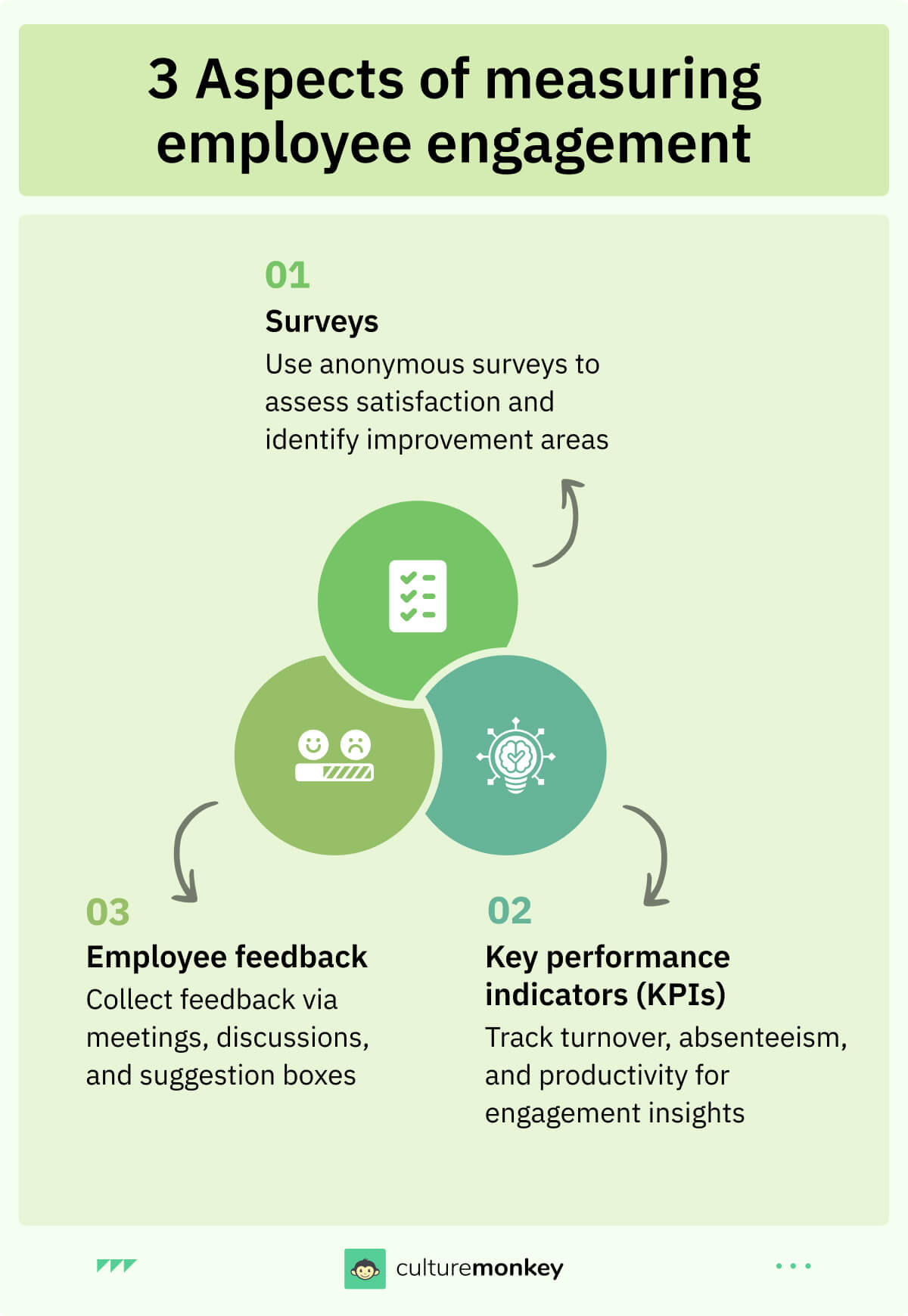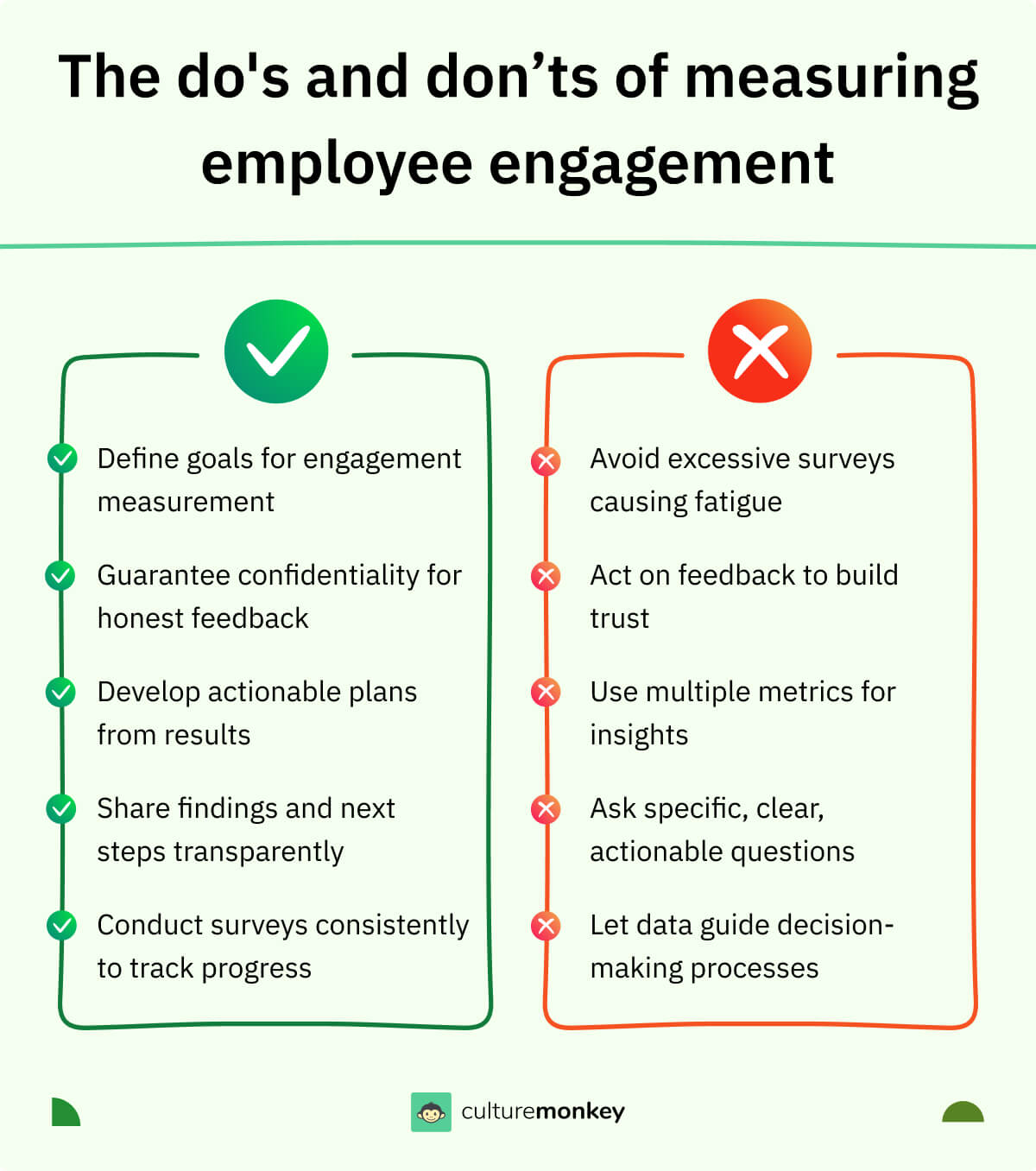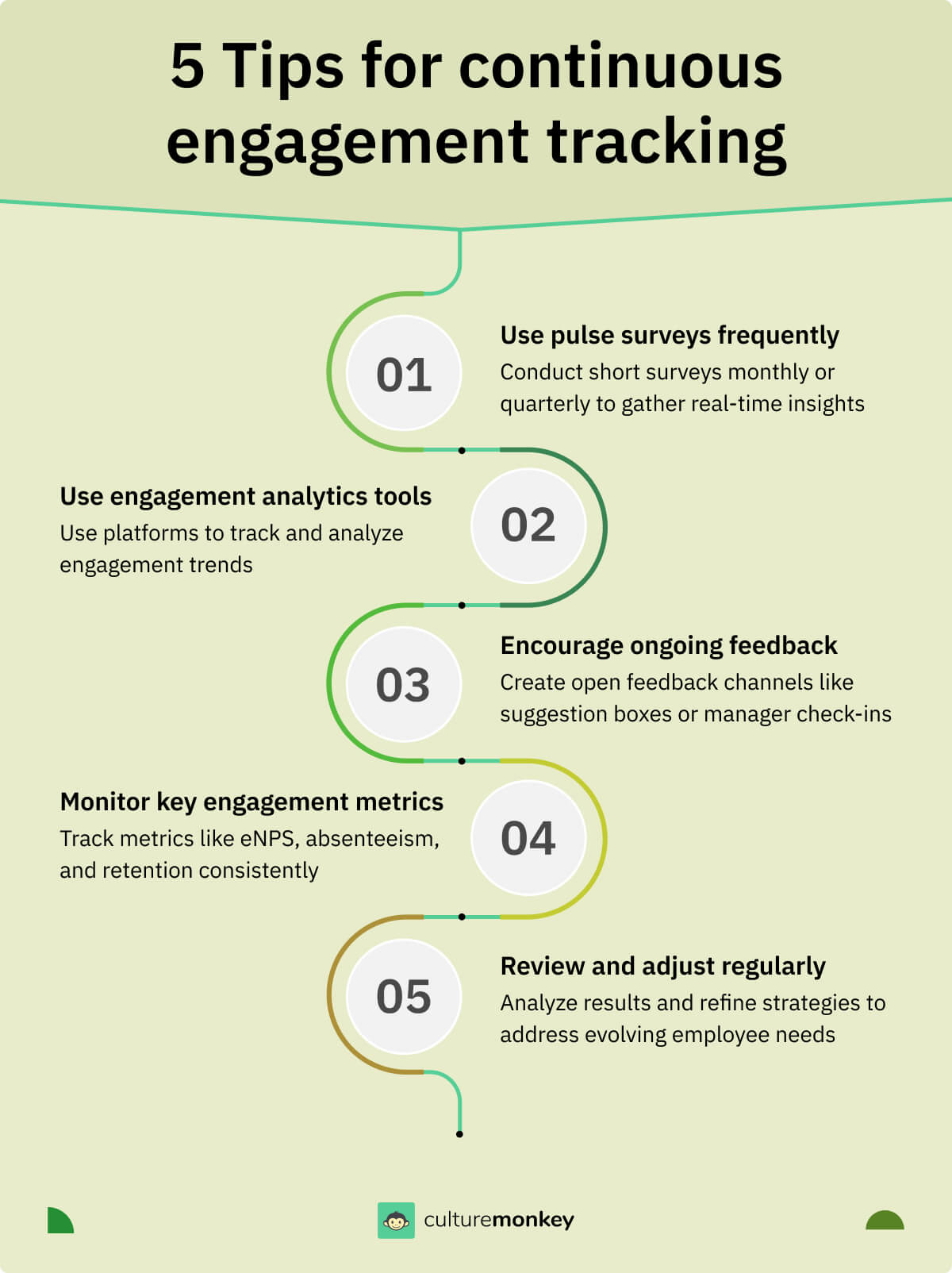Employee engagement measurement to boost productivity and culture in 2025

In 1914, legendary entrepreneur Henry Ford shocked the business world by doubling his employees' wages overnight. While many assumed this was just a publicity stunt, Ford had a sharp motive—happy, engaged workers build better cars and stick around longer. The results?
Skyrocketing productivity, reduced turnover, and a competitive edge that left rivals scrambling. Over a century later, the business world is still learning this timeless lesson: employee engagement isn’t just about ping-pong tables or free snacks; it’s about understanding what truly motivates your workforce and drives them to excel.
So, how do you measure something as intangible yet critical as employee engagement? Spoiler alert: it's not through annual surveys alone. This blog dives into actionable methods to gauge engagement, empowering you to build a motivated team that fuels your organization’s success.
Blog Highlights


What are employee engagement metrics?

Employee engagement metrics are crucial indicators that help HR leaders measure how engaged employees are at work. These metrics break down employees’ emotions toward the organization—covering areas like job satisfaction, workplace relationships, recognition, and personal well-being—into actionable data. This allows organizations to design strategies to improve or sustain engagement effectively.
One of the most effective ways to measure these metrics is through employee engagement surveys. These tools provide data-backed insights and templates, helping organizations understand how employees feel about their team, management, and workplace. Anonymous surveys encourage transparency, enabling employees to share honest feedback.
A Harvard Business Review survey of 500 executives revealed that 71% believe employee engagement is essential to achieving business goals. Engaged employees not only perform better but also drive workplace positivity and organizational success.
Regularly tracking and updating engagement metrics ensures accurate insights. In today’s competitive business world, investing in employee engagement isn’t optional—it’s a strategic necessity.



When employees are happy, they are your very best ambassadors.
Founder
Costco
Why should you measure employee engagement metrics?
Measuring employee engagement metrics is critical for driving employee satisfaction, performance, and organizational growth.
- Boosts employee performance and retention: Measuring engagement helps improve productivity and retain top talent within the organization.
- Enhances key business outcomes: Engaged employees positively impact profit, customer experience, innovation, productivity, and retention.
- Identifies engagement gaps: Metrics reveal areas needing improvement, such as addressing disengagement highlighted by SHRM's finding that only 34% of employees feel engaged.
- Reduces costs of disengagement: Disengaged employees cost companies up to $550 billion annually (HRDIVE).
- Empowers data-driven decision-making: Insights from metrics and surveys enable managers to enhance satisfaction, well-being, and overall engagement. Utilizing admin templates can efficiently visualize and analyze key data, streamlining decision-making processes with user-friendly dashboards.
- Supports strategic talent retention: Measuring engagement helps attract and retain top talent, fostering a positive workplace culture and long-term success.
13 Key employee engagement metrics to watch out for
Have you ever been on a road trip without a map or GPS? It's a risky endeavor, right? Well, managing a workforce without tracking key employee engagement metrics is no different.
To keep your organization on the right track, you need a dashboard of metrics that reveal how engaged your employees are. Let's dive into the 13 key employee engagement metrics you should be watching out for.
- Employee Net Promoter Score (eNPS): This classic metric gauges employee satisfaction by asking the question: "How likely are you to recommend our company as a place to work?" It categorizes employees as Promoters, Passives, or Detractors, giving you a clear picture of overall engagement.
- Employee Satisfaction (ESAT): ESAT surveys gather insights into employee happiness, helping you identify areas that need improvement. Happy employees are engaged employees.
- Employee turnover rate: High turnover can signal problems with engagement. It's costly to replace employees, so monitoring this metric is crucial.
- Absenteeism rate: Frequent absenteeism often reflects disengagement or burnout. Keep an eye on this to ensure your employees are not overburdened.
- Employee retention rate: The flip side of turnover, this metric shows how well you're retaining your talent. Engaged employees are more likely to stick around.
- Productivity levels: An engaged workforce is a productive one. Incorporating employee productivity monitoring into your key engagement metrics ensures a holistic understanding of how engagement impacts performance.
- Employee burnout rate: High levels of stress and burnout can lead to disengagement. Monitor employee burnout to address it proactively.
- Employee happiness index: Similar to ESAT, this metric provides a numerical representation of overall employee happiness.
- Employee feedback response rate: A low response rate to feedback requests may indicate disengagement. Encourage participation to get a more accurate picture.
- Employee development participation: Engaged employees seek opportunities for growth. Monitor participation in training and development programs.
- Employee referral rate: Employees who refer friends and acquaintances are often engaged and proud of their workplace.
- Employee recognition frequency: How often are employees recognized for their efforts? Frequent recognition is a sign of engagement.
- Manager-employee one-on-one meeting frequency: Engaged employees often have regular check-ins with their managers. Ensure these meetings are happening consistently.
What are the 3 aspects of measuring employee engagement?

Measuring employee engagement is crucial for any organization looking to create a thriving and motivated workforce. It's not just about keeping employees happy; it's about ensuring they are fully invested in their roles. So, let's delve into the three key aspects of measuring employee engagement that every savvy business should be aware of.
- Surveys: Regular employee engagement surveys help gauge organizational health. Include questions on work-life balance and whether employees feel valued. Keep surveys anonymous to encourage honesty and analyze responses to identify strengths and areas for improvement.
- Employee feedback: Foster two-way communication by encouraging employees to share thoughts and concerns openly. Use tools like one-on-one meetings, team discussions, and suggestion boxes to collect feedback. Employees who feel heard are more engaged and invested.
- Key performance indicators (KPIs): Track metrics like turnover rates, absenteeism, and productivity. High turnover or frequent absences signal disengagement, while increased productivity reflects strong engagement. These metrics provide measurable insights into engagement's impact.

What is the best KPI for employee engagement?
When it comes to measuring employee engagement, you want a KPI (Key Performance Indicator) that's like a compass guiding you through the organizational landscape. While there isn't a one-size-fits-all answer, one KPI often stands out as the best: the Employee Net Promoter Score (eNPS).
Employee Net Promoter Score (eNPS)
Think of eNPS as the "How likely are you to recommend our company as a place to work?" question. It's a simple yet powerful metric that provides a clear indication of your employees' engagement and satisfaction levels.
Here's how it works: Employees rate this question on a scale from 0 to 10, with 0 being "not likely at all" and 10 being "extremely likely." Then, they are categorized into three groups:
- Promoters (Score 9-10): These are your engaged and enthusiastic employees who are likely to recommend your company as a great place to work.
- Passives (Score 7-8): They're somewhat satisfied but not particularly enthusiastic. They're neutral and can swing either way.
- Detractors (Score 0-6): These are the disengaged or unhappy employees who might not recommend your organization.
To calculate your eNPS, subtract the percentage of Detractors from the percentage of Promoters. The result is your eNPS score.
So, why is eNPS often considered one of the best KPIs for employee engagement? It's straightforward, easy to understand, and can be measured regularly. Plus, it provides actionable insights. If your eNPS is high, you're doing something right. If it's low, it's a clear signal that improvements are needed.
However, remember that eNPS should not be the sole KPI you rely on. It's most effective when used alongside other metrics, such as turnover rates, absenteeism, and productivity.
These combined KPIs offer a holistic view of your employees' engagement levels, allowing you to make data-driven decisions to enhance the workplace and boost engagement.
How do you measure employee engagement?

Measuring employee engagement is like trying to capture the wind – it's intangible but essential for your organization's success. So, how do you measure this elusive yet crucial factor that can make or break your workplace? Let's break it down.
- Employee surveys: Think of these as your engagement barometer. Regular surveys with questions about job satisfaction, work environment, communication, and more provide valuable insights. Use standardized scales to quantify responses, making analysis easier.
- Net Promoter Score (eNPS): Similar to the NPS used for customer satisfaction, eNPS asks one simple question: "How likely are you to recommend our company as a place to work?" Responses help categorize employees as Promoters (engaged), Passives (neutral), or Detractors (disengaged).
- Pulse surveys: These are shorter, more frequent surveys designed to capture real-time employee sentiment. They provide snapshots of engagement levels throughout the year.
- 360-degree feedback: This involves gathering feedback from an employee's peers, supervisors, and subordinates. It offers a comprehensive view of their engagement and performance.
- Exit interviews: When employees leave, their insights can be invaluable. Conducting exit interviews can reveal why they disengaged and provide data for improvements.
- Employee feedback sessions: Regular one-on-one meetings between employees and managers encourage open communication and allow engagement-related issues to surface.
- Key Performance Indicators (KPIs): Metrics like turnover rates, absenteeism, and productivity can indirectly indicate engagement levels. High turnover or absenteeism may signal issues.
- Employee behavior: Observing how employees behave at work can provide insights. Engaged employees are proactive, collaborative, and take ownership of their roles.
- Employee recognition programs: Tracking the frequency and impact of employee recognition can indicate engagement. Engaged employees often receive more recognition.
- Work-life balance: Monitor employees' ability to maintain a healthy work-life balance. High engagement often correlates with better balance.
- Company culture: Assess the alignment of your company's culture with employee values and beliefs. A strong cultural fit often leads to higher engagement.
- Career development: Track participation in training, mentorship programs, and employee progression. Engaged employees typically seek growth opportunities.
- Employee well-being programs: Participation in programs promoting physical and mental well-being can reflect engagement levels.
- Innovation and idea sharing: Engaged employees are more likely to contribute ideas and innovations. Monitor idea generation and implementation.
- Leadership and managerial feedback: Collect feedback on managers and leaders to ensure they foster an engaged, motivated workforce.

Employee engagement key statistics

- Gallup's State of the Global Workplace 2023 report reveals that employee engagement has reached a record high of 23%, marking a significant increase since tracking began in 2009.
- Hubspot's research highlights that 69% of employees express a willingness to increase their work effort when they perceive their contributions are adequately acknowledged.
- As per The Conference Board's study on workplace engagement within the United States, disengaged employees contribute to an annual financial loss ranging between $450 billion to $550 billion for organizations.
- According to Korn Ferry, 33% of employees who opt to change jobs attribute their decision to a desire for fresh challenges and an escape from workplace monotony.
- McKinsey & Company's findings emphasize that an overwhelming 82% of employees believe that an organization's sense of purpose holds significant importance in their work environment.
Benefits of tracking employee engagement metrics

Employee engagement metrics – they may sound like just another task on your already overflowing HR to-do list. But trust me, tracking these metrics can be a game-changer for your organization. Let's dive into the incredible benefits of monitoring employee engagement metrics.
- Improved employee retention: High turnover rates can be a real headache (and budget-breaker). Tracking engagement metrics helps identify issues early, reducing turnover and the costs associated with hiring and training new employees.
- Enhanced productivity: Engaged employees are more productive. When you measure engagement, you gain insights into what motivates your team and can adjust strategies to boost productivity.
- Increased employee satisfaction: Happy employees are engaged employees. Monitoring engagement metrics allows you to pinpoint areas where satisfaction can be improved, leading to a happier workforce.
- Better company culture: A positive culture is a magnet for top talent. By tracking engagement metrics, you can actively shape and nurture a culture that attracts and retains the best.
- Enhanced recruitment: When your current employees are engaged and satisfied, they become your best recruitment advocates. They'll refer talented candidates, making your hiring process easier and more effective.
- Higher profitability: Engaged employees contribute to the bottom line. They're more innovative, customer-focused, and committed, which can result in increased profitability.
- Stronger employee loyalty: Engaged employees tend to be more loyal. By measuring engagement, you can build a team that sticks around for the long haul.
- Improved customer satisfaction: Engaged employees are more likely to provide exceptional customer service. Satisfied customers lead to repeat business and referrals.
- Enhanced innovation: Engaged employees are more likely to think creatively and suggest improvements. Tracking engagement metrics can help you identify and foster a culture of innovation.
- Reduced absenteeism: Engaged employees are less likely to call in sick or take unnecessary time off. Lower absenteeism rates save your organization money and keep projects on track.
- Better employee well-being: Engagement metrics can reveal stress or burnout patterns. By addressing these issues proactively, you can improve employee engagement, well-being and reduce health-related absences.
- More efficient onboarding: Understanding what engages your team helps streamline the onboarding process. New hires can become engaged and productive more quickly.
- Enhanced leadership development: Identifying and nurturing highly engaged employees can help you identify future leaders within your organization.
- Better performance management: Engagement metrics provide a basis for setting performance goals and evaluating progress.
- Regulatory compliance: Some industries require organizations to track and report employee engagement. Monitoring these metrics ensures compliance with regulations and avoids potential penalties.
Challenges in employee engagement measurement
Accurately measuring employee engagement is essential for organizational success, yet it presents several challenges:
- Subjectivity of engagement: Employee engagement is inherently subjective, varying across individuals and teams. This variability complicates the development of standardized measurement tools that accurately capture diverse experiences.
- Dynamic workforce demographics: The increasing diversity in age, culture, and work preferences necessitates adaptable engagement measurement strategies. Traditional methods may not effectively address the unique needs of a multifaceted workforce.
- Integration of qualitative insights: While quantitative data is valuable, it often lacks the depth provided by qualitative feedback. Incorporating open-ended responses and interviews is resource-intensive but crucial for a comprehensive understanding of engagement levels.
- Rapid technological advancements: The swift evolution of workplace technologies can outpace existing engagement measurement tools, rendering them obsolete. Continuous updates and training are necessary to ensure measurement methods remain relevant.
- Alignment with organizational objectives: Ensuring that engagement metrics align with evolving business goals requires regular reassessment. Misalignment can lead to initiatives that do not effectively support organizational success.
- Data privacy concerns: Collecting engagement data involves handling sensitive employee information. Organizations must navigate privacy regulations and build trust to encourage honest feedback without fear of repercussions.
How to measure employee engagement metrics?

Measuring employee engagement involves tracking various aspects like satisfaction, commitment, and motivation. In a hybrid work environment, multiple metrics are required to obtain actionable insights and drive employee engagement.
- Annual engagement surveys: Comprehensive surveys conducted yearly provide a big-picture understanding of employee commitment, motivation, and morale. They help HR leaders identify trends and areas for improvement through in-depth data.
- Pulse surveys: Short and frequent surveys track immediate feedback on specific areas like workplace relationships or work-life balance. These surveys offer real-time insights, helping organizations address issues promptly.
- Employee net promoter score (eNPS): eNPS measures employees' willingness to recommend the company to others. It provides actionable data on satisfaction and loyalty, with a high score reflecting a positive workplace culture.
- Work-life balance: This metric evaluates how employees manage personal and professional responsibilities. Surveys help identify stressors and prevent burnout, ensuring employee health and productivity.
- Recognition: Tracking how often employees feel appreciated highlights areas where management can improve acknowledgment efforts. Employee recognition boosts morale, loyalty, and engagement.
- Professional development: This metric assesses growth opportunities provided to employees. Supporting career advancement helps retain talent and boosts employee motivation.
- 1-on-1 meetings: Regular 1-on-1s provide opportunities for personalized feedback and discussion. These meetings help employees feel heard and improve engagement through direct communication.
- Survey participation rate: The percentage of employees who respond to surveys indicates engagement levels and survey effectiveness. A low participation rate can signal disengagement or survey fatigue.
- Diversity and inclusion index: This metric evaluates employees’ perceptions of diversity, equity, and inclusion. A diverse and inclusive environment fosters collaboration, belonging, and innovation, boosting overall engagement.

How not to measure employee engagement
Accurately measuring employee engagement is vital for organizational success; however, certain practices can lead to misleading results:
- Relying solely on quantitative data: Focusing only on numerical metrics, such as turnover rates or absenteeism, without considering qualitative insights can provide an incomplete picture of employee engagement. Incorporating employee feedback and open-ended survey responses is essential for a comprehensive understanding.
- Infrequent assessments: Conducting engagement surveys annually or less often fails to capture the dynamic nature of employee sentiment. Regular, more frequent assessments are necessary to monitor changes and address issues promptly.
- Using generic survey instruments: Employing standardized surveys without tailoring questions to reflect the unique culture and context of the organization can result in irrelevant data. Customizing engagement measurement tools ensures alignment with organizational goals and employee experiences.
- Neglecting to act on survey results: Collecting engagement data without implementing changes based on the findings can lead to employee cynicism and decreased participation in future assessments. Demonstrating a commitment to addressing identified issues is crucial for maintaining trust and engagement.
- Overlooking the impact of leadership behavior: Failing to assess how leadership styles and behaviors influence employee engagement can result in missed opportunities for improvement. Evaluating and developing leadership practices is essential for fostering a positive work environment.
- Assuming high performance equals high engagement: Presuming that productive employees are inherently engaged overlooks underlying issues such as burnout or dissatisfaction. It's important to assess engagement levels directly rather than making assumptions based on performance metrics alone.
Why should you measure employee engagement metrics in Hybrid work?

"People are more productive working at home than people would have expected. Some people thought that everything was just going to fall apart, and it hasn't. And a lot of people are actually saying that they're more productive now." – Mark Zuckerberg
Monitoring employee engagement metrics in a hybrid work model is crucial to sustaining productivity and employee satisfaction.
- Adapt to changing work dynamics: Hybrid work demands tracking emotional commitment as employees balance remote and in-office setups.
- Boost productivity: While 58% of executives report improvements (McKinsey & Company), monitoring ensures consistent performance across teams.
- Prevent engagement drop-offs: Engagement is critical for business success; low engagement can harm organizational growth.
- Leverage hybrid work benefits: Many employees thrive in hybrid setups, making it essential to maintain high engagement levels.
- Identify challenges early: Regularly tracking metrics helps address productivity or communication issues unique to hybrid models.
Key employee engagement metrics for the hybrid work environment

According to Upwork, 37% of employees might consider looking for a new job if they can't work remotely, so changing the hybrid to entirely on-site is not an option. The following four employee engagement metrics would help you monitor your engagement for better hybrid work productivity of your employees -
- Leadership effectiveness indicators: Leaders’ communication impacts team success in achieving company goals. Effective leadership fosters connection, boosting productivity by 71% when employees feel connected (Business Wire).
- Employee behavior indicators: Tracks employee competencies like teamwork, decision-making, and communication. Helps identify disengaged employees, with Gallup reporting 51% of employees are psychologically unattached to their work.
- Early outcome metrics: Measures immediate business outcomes like productivity, participation in development, and escalation challenges. These metrics help inform decisions based on data-driven insights.
- Lagging results impact metrics: Tracks long-term outcomes like revenue and retention to assess overall performance. While useful, they may delay adjustments, making leading metrics essential for ongoing improvements.
- Mental health and well-being support: Prioritizes employee mental health through counseling and resources. Effective programs reduce stress, improve engagement, and demonstrate commitment to employee welfare.
- Technology infrastructure and accessibility: Ensures employees have equitable access to tools and reliable systems for efficient hybrid work. Metrics include system reliability and IT support effectiveness.
- Work-life integration metrics: Tracks overtime, burnout, and flexible work usage to assess work-life balance. Supports employee well-being and satisfaction in hybrid environments.
- Diversity, equity, and inclusion (DE&I) metrics: Measures diversity in hiring, promotions, and perceptions of inclusivity. Fosters a more equitable and engaged workforce by identifying areas for improvement.
- Training and development effectiveness: Tracks participation in training sessions and skill application. Investing in employee growth enhances engagement and retention, ensuring adaptability in hybrid work settings.

Reimagine employee surveys
with better questions
Stop guessing and start asking—discover what really drives employee engagement and learn how to craft surveys that deliver impactful insights and actionable results.
Methods for measuring employee engagement
Accurately measuring employee engagement is essential for organizational success. Beyond traditional surveys and feedback mechanisms, several innovative methods can provide deeper insights:
- Natural language processing (NLP) analysis: Implementing AI-driven tools like Intelligent Pulse (I-Pulse) enables the evaluation of large volumes of employee feedback from pulse surveys. These tools analyze textual data to extract actionable insights, helping organizations understand employee sentiments and engagement levels more effectively.
- Employee experience platforms: Utilizing comprehensive platforms that integrate recruitment, engagement tracking, and improvement tools offers a holistic approach to managing employee engagement. These platforms facilitate continuous monitoring and enhancement of the employee experience throughout their lifecycle.
- Behavioral analytics: Analyzing patterns in employee behavior, such as collaboration frequency, participation in meetings, and utilization of company resources, can provide indirect indicators of engagement. This method helps identify trends and areas needing attention without relying solely on self-reported data.
- Social network analysis: Examining the informal networks within an organization reveals how information flows and how employees interact. Understanding these social structures can highlight key influencers and potential areas of disengagement.
- Stay interviews: Conducting interviews with current employees to understand why they choose to remain with the organization provides valuable insights into engagement drivers and areas for improvement. Unlike exit interviews, stay interviews focus on retention strategies.
- Real-time feedback tools: Implementing platforms that allow for continuous, real-time feedback enables organizations to address concerns promptly and adapt strategies to maintain high engagement levels.
What to do after measuring the employee engagement metrics?

Measuring employee engagement metrics is only the first step. You must commit to continuously improving engagement as a people leader. After measuring the employee engagement metrics, it's time for you to communicate and work to improve things irrespective of the workforce is on-site or hybrid.
- Be more transparent: Transparency fosters trust and engagement, as employees feel more connected and valued. According to Forbes, 50% of employees believe there is a lack of company-wide transparency, which impacts trust and retention.
- Improve for employees: Constantly innovate to meet employees' needs and provide career development opportunities. With 34% of employees leaving jobs due to lack of growth (Lorman), prioritizing engagement metrics ensures teams stay informed and skilled.
- Repeat the process: Engagement improvement is an ongoing process. Use data to share, implement, and reassess action plans regularly as operations and workforce complexity evolve.
- Recognition and appreciation: Acknowledge and celebrate employee achievements to boost morale and motivation. Programs like peer recognition and public acknowledgment create a culture of appreciation and engagement.
- Clear communication channels: Establish open communication platforms to address employee concerns and share updates. Regular assessments of tools like meetings and newsletters improve transparency and foster trust.
- Flexible work arrangements: Provide options like remote work and flexible hours to support work-life balance. Tailoring flexibility based on engagement metrics enhances employee well-being and satisfaction.
- Employee development plans: Use engagement insights to design personalized growth plans. Offering training, mentorship, and career advancement opportunities keeps employees motivated and invested in the organization.
- Employee feedback loop: Create a continuous feedback system through surveys and discussions. This helps organizations adapt engagement strategies based on evolving employee needs, fostering ongoing improvement.
What are employee engagement drivers?

Employee engagement isn't a mysterious, elusive concept—it's all about understanding what drives your team to give their best every day. Let's dive into the fascinating world of employee engagement drivers.
- Leadership and management: Imagine having a manager who inspires you, guides you, and genuinely cares about your growth. That's a key driver of employee engagement. Leadership sets the tone for the entire organization. When leaders lead by example, communicate clearly, and provide regular feedback, they create an environment where employees feel valued and motivated.
- Recognition and appreciation: Remember the last time someone acknowledged your hard work? It feels pretty darn good, right? Recognizing and appreciating employees' efforts is a potent engagement driver. Whether it's a simple "thank you" or a formal recognition program, showing appreciation boosts morale and makes employees feel that their contributions matter.
- Career development opportunities: No one wants to feel stuck in a dead-end job. Career development opportunities are a significant driver of engagement. When employees see a clear path for growth within the organization, they're more likely to stay committed and motivated. Offering training, mentorship, and advancement prospects not only benefits employees but also strengthens your workforce.
- Work-life balance: A healthy work-life balance is essential for keeping employees engaged. When people are overworked and stressed, their engagement levels plummet. Encouraging flexible schedules, promoting self-care, and respecting personal boundaries can go a long way in maintaining that balance.
- Company culture: Company culture is the collective personality of your organization. A positive, inclusive, and vibrant culture is a massive engagement driver. It fosters a sense of belonging and pride among employees. Investing in building a strong culture pays dividends in terms of engagement and retention.
- Feedback and communication: Effective communication and feedback mechanisms are crucial. Employees want to be heard and know that their opinions matter. Regular feedback sessions, surveys, and open-door policies create an atmosphere where ideas flow freely, driving engagement.
- Workplace environment: A comfortable, well-designed workspace can significantly impact engagement. It's not just about aesthetics; it's about creating an environment that promotes collaboration, creativity, and overall well-being.
Tracking key engagement metrics: Automate your processes
Have you ever tried to juggle a dozen balls at once? It's challenging, right? Well, tracking key engagement metrics in your organization can feel a bit like that. But fear not, because there's a nifty solution: automating the process with employee engagement survey tools.
Why automate your tracking process?
Imagine manually sending out surveys, collecting responses, and trying to make sense of the data. It's time-consuming and prone to errors. Automation, on the other hand, streamlines the entire process, making it more efficient and accurate.
Here's how it can help:
- Efficiency: Employee feedback tools automate survey distribution and data collection. You can set up surveys to go out at regular intervals, reducing the administrative burden on your HR team.
- Real-time data: With automation, you can collect data in real-time. No more waiting for manual data entry and analysis. This means you can respond to engagement issues promptly.
- Customization: These tools often allow you to customize surveys to fit your organization's specific needs. Tailor questions to gather the insights that matter most to you.
- Data analysis: Many tools come with built-in analytics features that transform raw data into actionable insights. You can spot trends, identify areas for improvement, and track progress over time.
- Employee privacy: Automation tools ensure data security and anonymity for employees, fostering honesty in responses.
- Consistency: Automated surveys ensure that all employees receive the same questions and have equal opportunities to provide feedback.
- Scalability: As your organization grows, so does the volume of data. Automation scales effortlessly to handle a larger workforce and more data points.
- Feedback loops: Some tools facilitate feedback loops by sending automated responses or actions based on survey results. This can include follow-up surveys or alerts for HR to address specific issues.
- Time savings: By automating surveys and data analysis, your HR team can invest their time in developing engagement strategies rather than managing administrative tasks.
- Report generation: Many tools generate comprehensive reports that make it easy to communicate survey results to leadership and employees.
In a nutshell, annual employee engagement survey tool or frequent employee engagement survey tools take the complexity out of tracking key metrics. They make the process more efficient, accurate, and actionable, allowing you to create a workplace where employees are engaged, motivated, and thriving.
So, if you're juggling those engagement metrics like a pro, it might be time to let technology lend a hand and make your life easier.
Conclusion
Modern employee engagement has changed tremendously in recent years due to environmental complexities and technology-aided workplaces.
So, it's up to you! As engaged and motivated employees are more productive. Adapting and boosting their engagement levels through employee engagement metrics and other modern engagement methods will help to spot and resolve issues early.
With CultureMonkey's employee engagement survey software, you can make your employees' voices heard, value your employees' productivity, increase workplace engagement, reduce attrition, maximize business outcomes, and improve workplace culture.
So, as a people leader, boost and adapt to modern employee engagement and here is where CultureMonkey's research-oriented employee onboarding survey stands tall.
CultureMonkey's employee engagement platform enables you to send relevant and personalized survey questions per your specific and individual requirements.
Make sure you strategically approach your employees working across locations and benefit from the deep insight that emerges as you add layers to your employee engagement through multiple employee engagement metrics.
Summary
Measuring employee engagement metrics helps organizations understand employee satisfaction, motivation, and connection. Metrics like response rates, eNPS, retention, and absenteeism identify strengths and improvement areas.
When used effectively, these metrics provide actionable insights, enhance workplace culture, and foster transparency and trust. This leads to a more engaged, productive, and loyal workforce, driving organizational success.
FAQs
1. What are the key employee engagement metrics to track?
Key employee engagement metrics to track include Employee Net Promoter Score (eNPS), employee satisfaction, turnover rates, absenteeism, productivity levels, 360-degree feedback, employee recognition frequency, career development participation, work-life balance, and company culture alignment.
2. How do I measure employee engagement in my organization?
To measure employee satisfaction and engagement, you can employ methods such as employee surveys, Net Promoter Score (eNPS) surveys, pulse surveys, 360-degree feedback, exit interviews, key employee performance indicators (KPIs) like turnover and employee absenteeism rate, and regular one-on-one meetings between employees and managers. These methods gather data on job satisfaction, work environment, communication, and more.
3. Which tools can help automate the tracking of employee engagement metrics?
Several tools can automate employee engagement metric tracking, including survey software, performance management systems, and HR analytics platforms. These tools streamline survey distribution, data collection, analysis, reporting, actionable insights, data visualization, feedback loops, and progress tracking. They enable real-time monitoring, continuous improvements, better decision-making, and the development of strategies to enhance employee satisfaction and overall workplace engagement effectively.
4. What are some best practices for analyzing and improving employee engagement metrics?
Best practices for analyzing and improving employee engagement metrics include setting clear goals, benchmarking against industry standards, proactively addressing issues, fostering a positive culture, providing career development opportunities, recognizing achievements, and maintaining open communication. Involving employees in the process ensures actionable feedback, while consistent efforts to improve engagement drive satisfaction, productivity, and long-term organizational success.
5. Can we measure employee engagement without surveys?
Employee engagement surveys are a reliable way to measure engagement, offering structured, quantifiable data that highlights trends and areas for improvement. Unlike informal methods such as feedback sessions or observation, surveys provide a comprehensive and consistent approach, ensuring actionable insights. By identifying key engagement drivers, surveys help organizations enhance workplace satisfaction, productivity, and overall performance effectively.
6. How do we connect engagement metrics with business outcomes like revenue or customer satisfaction?
Employee engagement metrics can directly impact business KPIs such as revenue, customer satisfaction, and productivity. By correlating engagement scores with outcomes like NPS or retention, organizations can demonstrate ROI. This connection shifts engagement from a soft metric to a strategic driver, helping leadership prioritize culture-building as a key lever for performance and growth.
7. How do we prevent engagement surveys from becoming ‘tick-box’ exercises?
To ensure surveys aren’t just routine tasks, organizations must act visibly on feedback. Share results transparently, involve employees in decision-making, and implement quick wins. When people see their voices shaping workplace improvements, surveys gain credibility. This builds trust, boosts participation, and transforms employee engagement measurement into an impactful and continuous driver of cultural and operational improvement.




